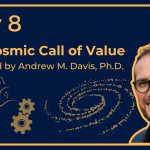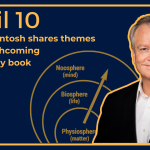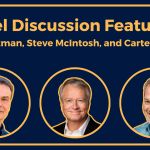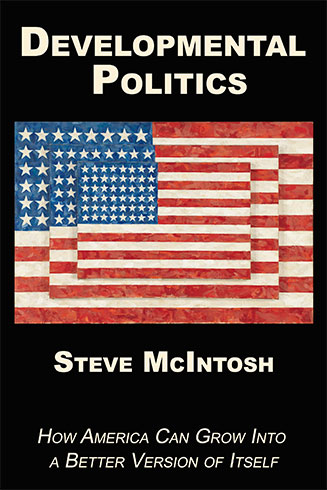The Presence of the Infinite
Chapter 5: Contemporary Spiritual Currents: Progressive and Nondual
. . . [In this chapter] we consider the most recent trends in progressive spiritual culture that have become evident since the turn of the millennium, leading to the conclusion that progressive spirituality is reaching a kind of maturity or culmination through its growing agreement regarding the nondual nature of ultimate reality. And this agreement itself is arising from the partial merger of the practices and truth teachings of Advaita Vedanta Hinduism and Westernized progressive Buddhism. . . .
Once we have examined the recent maturation of progressive spirituality and the evolutionary opportunity this creates, we will be ready to explore in the next chapter how evolutionary spirituality can use this opportunity to transcend the limitations of progressive spirituality and thereby achieve the next dialectical step in our society’s cultural evolution. . . .
An Existential Spiritual Polarity Becomes More Clearly Visible
The rise of nonduality as the mature expression of progressive spirituality provides new insight into the landscape of spiritual experience itself. As discussed above, the teaching that ultimate reality is essentially nondual has now brought together most of the major strands of progressive spirituality into a widespread cultural agreement. And the emergence of this agreement itself makes clear that nonduality is a vital and authentic aspect of spiritual reality.
However, no matter how popular this teaching may become and no matter how authentic the spiritual experience of nonduality may be, this does not negate or subordinate the experiential authenticity or cultural significance of other current forms of spirituality that are not nondual. In other words, within the spiritual marketplace of ideas, both contemporary and historical, other equally venerable kinds of spirituality can be found whose teachings point in a somewhat different direction. While some proponents of nondual spirituality contend that such alternative teachings are simply lower, or less true, the experience of nonduality itself does not justify such a conclusion. In fact, one of the virtues of a nondual unitive experience is that it is completely transconceptual, so it does not lend itself well to conceptual claims of belief system superiority.
As a result of its welcoming pluralism, the culture of progressive spirituality continues to embrace a wide variety of convictions regarding the character of ultimate reality. Yet even when we account for the full spectrum of diversity and acknowledge the myriad ways that people can experience spirit, when we survey the field of contemporary spirituality a clear pattern can be discerned. And as I will argue through the rest of this chapter, this evident pattern within spiritual experience points to two fundamental ways in which ultimate reality is most often experienced by spiritual practitioners: either it is experienced as unqualified unity, or it is experienced as a transcendent Creator. Simply put, spiritual experience itself reveals two essential kinds of ultimate reality, which can be loosely identified as nondual and theistic.
These two fundamental conceptions of ultimate reality, however, are not just lying next to each other as alternative possibilities. Their dynamic relationship produces an interactive structure that takes the form of an existential polarity. That is, within the ideational and experiential terrain of humanity’s search for ultimate meaning and value a dialectical tension exists between two essential conceptions of ultimate reality. And as discussed in chapters 2 and 4, existential polarities such as this can be recognized as systems of development providing openings for further evolution. . . .
The Polarity Exists within Spiritual Experience Itself
The experience of spirit itself seems to divide naturally into two distinct categories that provide the foundation and determine the teaching themes for the nondual and theistic forms of spirituality we are exploring. As we have seen, nondual versions of spirituality are founded primarily on the universal mystical experience of formless unity. As Advaitan teacher Nisargadatta Maharaj wrote, “When you go beyond awareness, there is a state of non-duality, in which there is no cognition, only pure being. In the state of non-duality, all separation ceases.” Conversely, theistic versions of spirituality rest upon another kind of deep and foundational spiritual experience—the love of God. For those who have a direct relationship with God, the experience of being personally known and cared for by the Creator of the universe is a thrilling confirmation of their faith. As Saint Augustine wrote, “God loves each of us as if there were only one of us.”
But while formless unity is the experiential foundation of the nondual pole and the love of God is the experiential foundation of the theistic pole, the experience of God’s love is not a perfect polar mirror of the nondual unitive experience. The experiential basis for theistic spirituality is more varied and not always mystical in character. Theistic spiritual experiences can include awareness of loyalty and duty, as well as the other “natural signs” discussed at the end of chapter 3. Such experiences can also include a sense of love, not just from God but from other spiritual sources, such as from Christ. For example, philosopher and mystic Simone Weil described her experience of Jesus as “the presence of love, like that which one can read in the smile on a beloved face.”
Some have argued that the apparent differences found in descriptions of essential spiritual experience can be reduced to interpretive constructions designed to justify previously established belief systems. Others contend that such differences are due to the indeterminate nature of spiritual reality, which is said to be best understood as a wide ocean of diversity rather than as a structured polarity. However, after reflecting on this subject for quite some time, it seems to me that the polar opposition I am describing does not result simply from previously held biases toward doctrinal commitments. My conclusion is that the polar tension between theism and nonduality reflected in the overall world body of spiritual teachings about ultimate reality results from a polarity in the human experience of ultimate reality itself, rather than the other way around. In short, the experiences produce the polarity in the teachings more than the teachings produce the polarity in the experiences. . . .



